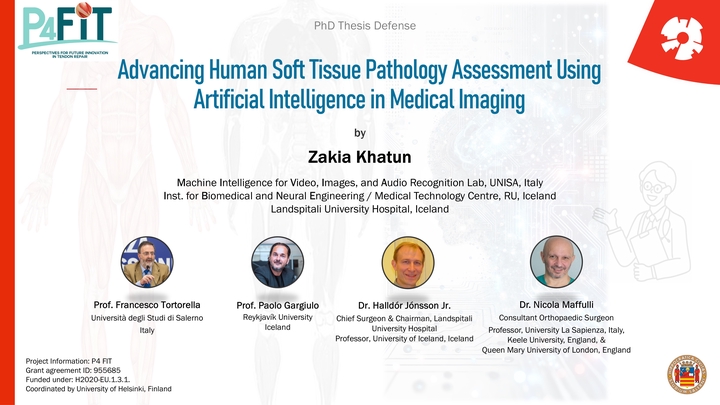Advancing Human Soft Tissue Pathology Assessment Using Artificial Intelligence in Medical Imaging
The abstract of my PhD thesis

Abstract
Artificial Intelligence (AI) has revolutionized various fields by automating complex tasks, uncovering patterns in large datasets, and making accurate predictions. Machine learning, particularly deep learning, plays a pivotal role in enabling AI to emulate human intelligence for tasks such as image segmentation, classification, and recognition. In the realm of medical imaging, modalities like Magnetic Resonance Imaging (MRI), Computed Tomography (CT), and Ultrasound are indispensable tools for diagnosing pathologies, detecting abnormalities, guiding treatment plans, and monitoring disease progression. The integration of AI with medical imaging offers the potential to enhance the accuracy and efficiency of these processes.
In particular, AI’s application in the assessment of tendon-related conditions, such as tendinopathy, presents a promising avenue for improving patient care. Tendinopathy can significantly impact a patient’s quality of life, and early detection is crucial to optimize treatment outcomes. This thesis focuses on the development of advanced AI-driven methods for analyzing human soft tissue pathologies, with a primary emphasis on tendon segmentation, pathology detection (classification), and tendon reflex response assessment. By automating the analysis of tendons and other human soft tissues, these methods aim to reduce human error and variability, thereby enabling more consistent and reliable clinical decisions. Ultimately, the goal is to support earlier, more accurate diagnoses and interventions, leading to better patient outcomes and more personalized treatment strategies.
This thesis begins with a study that analyzes MRI and CT scans from 47 participants to investigate the relationships between the tendons, cartilage, and muscles in the knee. This study has two primary objectives - first, to predict knee cartilage degeneration, and second, to predict patellar tendinopathy. For both objectives, predictions are made using features extracted solely from the patellar tendon and quadriceps, rather than directly from the cartilage itself. This approach explores the potential of using features from surrounding tissues as indirect predictors of knee-related pathologies. This study demonstrates that both knee cartilage degeneration and patellar tendinopathy can be predicted using these features from adjacent structures, highlighting the importance of surrounding tissues as potential indicators of pathology. Traditional machine learning models are employed to identify the most relevant features for each prediction task, highlighting their importance in the diagnosis of these conditions. This foundational research deepens our understanding of the interrelationships between knee soft tissues, contributing to more accurate diagnostic approaches in musculoskeletal health and enhancing clinical decision-making and treatment strategies.
A central focus of this thesis is the development of an end-to-end tendon segmentation module. This system integrates a superpixel-based coarse segmentation step that serves as a foundation for the final, more precise segmentation. In this approach, the segmentation task is framed as a superpixel classification problem. To achieve this, two distinct approaches are developed - (1) Random Forest (RF) and Support Vector Machine (SVM) classifiers for superpixel categorization, and (2) a Graph Convolutional Network (GCN) for transforming superpixels into graph structures for node classification. The RF and SVM classifiers demonstrate exceptional performance, achieving Area Under the Curve (AUC) scores of 0.992 and 0.987, respectively, with high sensitivity, indicating their effectiveness in accurately classifying superpixels. Although the GCN approach yields slightly lower performance, it showcases the potential of deep learning methods for improving segmentation by leveraging the structural relationships between superpixels. The findings suggest that both traditional machine learning and deep learning techniques offer promising avenues for advancing tendon segmentation, with superpixel-based methods offering a pathway to more reliable and automated segmentation in medical imaging.
Another key component of this thesis is the development of an end-to-end tendon pathology detection module, utilizing the same MRI dataset. This module adopts a graph-based approach, where superpixels are treated as nodes and connected by edge relationships. Each MRI scan is transformed into a graph, with the task framed as a graph classification problem to determine the presence or absence of pathology. To achieve this, a Graph Echo State Network (GESN) is employed. Known for its ability to efficiently represent data without the need for iterative backpropagation, the GESN leverages both temporal and structural dependencies in the data, enhancing classification performance. In this study, the GESN outperforms traditional machine learning models, achieving a mean accuracy of 0.953 and a sensitivity of 0.943. These results underscore the potential of the GESN to significantly enhance diagnostic accuracy, offering a powerful tool for early detection and clinical decision-making in tendon pathology assessment. Moreover, the GESN’s ability to handle complex, high-dimensional data suggests its broad applicability to other medical imaging tasks, further expanding its potential clinical utility.
The final study of this thesis explores the impact of demographic factors, including age, height, weight, and gender, on reflex response times in healthy individuals. This analysis is based on electromyography (EMG) recordings from 40 participants. The results reveal that elderly individuals, particularly those who are taller, heavier, and male, exhibit delayed reflex onsets. Even after normalizing for height, older participants still demonstrate slower reflex responses. These findings highlight the role of demographic factors in neuromuscular reflexes, aiding in the diagnosis and early detection of related disorders.
In conclusion, this research demonstrates the potential of AI, particularly superpixel-based and graph-based models, to advance tendon pathology assessment and exploratory tendon reflex studies, leading to better patient outcomes and musculoskeletal health management.